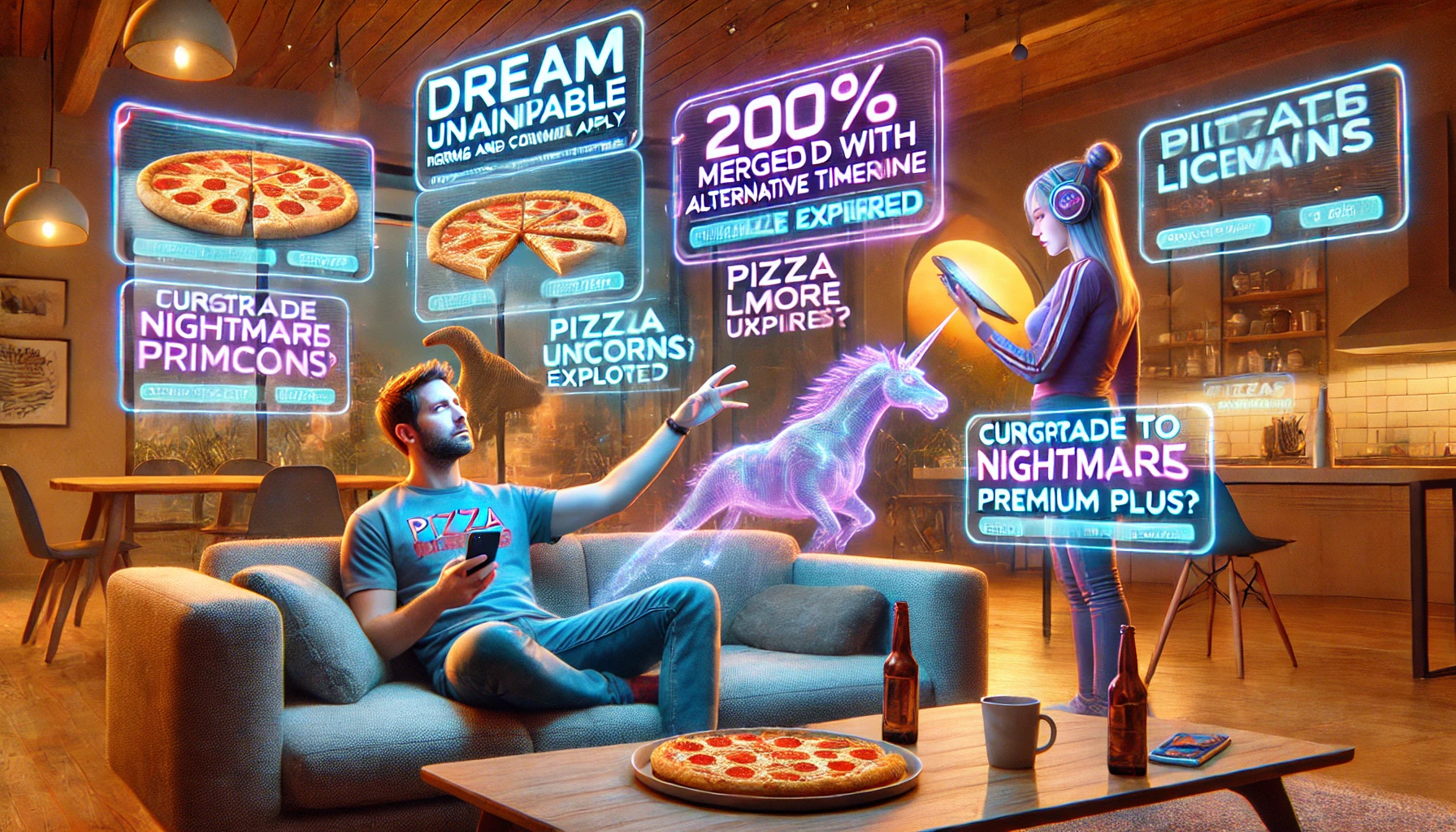Almost every day my wife retells me her dreams. “Honey, I had an interesting dream this night,” and she tells me a story with a twisted plot, bright visuals, and crazy dialogs. I thought, what if there was a device to record a person’s dreams? Something like a pair of earbuds that you place on the person’s head and download the last night’s dream. Then I imagined a company, or the whole industry that would sell a service to store your dreams in the cloud and make them available for rewatching. Please write a sci-fi story about it. I think there should be some attributes that we are too familiar with today: a 27-page license agreement that nobody reads, data leaks, account breaking on politicians’ and celebrities’ accounts, NSFW dreams, etc. “Honey, I had a very interesting dream recently, let’s watch it together… Oh, wait, sorry, that’s not the dream I wanted to show you… No, it’s not what you think, please don’t start…”
The problem with DreamFlix wasn’t the technology—the Neural Sleep Recorders worked perfectly fine. It wasn’t the monthly subscription fee either (though $14.99 did seem a bit steep just to remember your own dreams). No, Tom’s issue with DreamFlix was their customer service, which he was currently experiencing in all its automated glory.
“To better assist you,” chirped the AI assistant’s voice in his ear, “please state the nature of your dream emergency.”
“It’s not an emergency,” Tom said for the fourth time. “I just want to know why my dream from last Tuesday shows up as ‘Content Unavailable: Merged with Alternative Timeline.’”
“I understand you’re having trouble accessing premium content. Please note that as per Section 1,349 of our Terms of Service, dreams involving dinosaurs, supernatural beings, or your high school math teacher are subject to additional licensing fees.”
“What? No, listen—”
“Would you like to upgrade to our Nightmare Premium Plus package? For just $7.99 more per month, you can access unlimited anxiety dreams and receive personalized dream predictions based on your daily stress patterns!”
Tom rubbed his temples. He’d been at this for two hours. Meanwhile, his girlfriend Jenny was waiting at her place, excited to show him what she claimed was “the most amazing dream ever.” He’d promised to watch it with her as soon as he sorted out his own dream archive.
“Look,” he tried again, “can I speak to a human representative?”
“Our human representatives are currently dreaming. Would you like to schedule a meeting in their dreams? Please note that dream meetings are only available to Enterprise Plus subscribers.”
Tom hung up and opened the DreamFlix app instead. Maybe he could figure this out himself. The interface loaded with its usual cheerful message: “Welcome back! You have 47 unwatched anxiety dreams and 3 pending dream requests from your mother.”
He scrolled through his dream feed. There was last night’s dream (tagged as “Basic Dream: Man Shows Up to Important Meeting Without Pants - Classic Edition”), some scattered fragments from naps (“Power Nap Premium Content - Subscribe to Complete These Dreams!”), and… wait, what was that?
A notification popped up: “Your dream ‘Flying Over City While Eating Pizza’ has been claimed for copyright infringement by PizzaDreams Inc. Please verify your pizza consumption license.”
“Oh, for crying out—”
His phone buzzed. Jenny was calling.
“Hey, are you coming over? You have to see this dream! I finally mastered lucid dreaming and—” She paused. “Why do you sound so frustrated?”
“DreamFlix is being impossible. They’ve locked half my dreams behind paywalls, and apparently, I need a license to dream about pizza now.”
“Oh no,” Jenny laughed. “Did you get the pizza copyright notice too? Here’s a tip: just change the dream tags to ‘Circular Food Item of Unspecified Origin’ and they’ll leave you alone.”
Tom brightened. “Really? That works?”
“Usually. Unless PizzaDreams’ AI is having a bad day. Then you have to fill out their ‘Non-Pizza Dream Verification Form’ in triplicate, while sleeping.”
Tom arrived at Jenny’s place twenty minutes later. She was practically bouncing with excitement as they sat down to watch her dream.
“Okay,” she said, pulling up the DreamFlix app, “prepare to be amazed by—” Her face fell. “Oh no.”
The screen displayed: “This dream has been automatically merged with our new AI Dream Enhancement™ feature. Would you like to view: a) The original dream, b) The AI-improved version with 200% more unicorns, or c) A dream personally curated for you based on your browsing history?”
“Let me guess,” Tom said. “You didn’t read the terms and conditions update they sent last week?”
“There were 487 pages! Who reads those?”
“According to Section 7,592, paragraph 3, subsection Q: ‘Nobody, that’s who, and we’re counting on it.’”
They looked at each other and burst out laughing. Jenny closed the app.
“Want to do something really crazy?” she asked. “We could try actually telling each other about our dreams. You know, like people did in the old days.”
“Without neural interface verification? Is that even legal?”
“Probably not. But I won’t tell if you won’t.”
As Jenny started describing her dream, Tom relaxed into her couch, enjoying the completely unmonetized, un-enhanced, and totally subscription-free experience. Of course, somewhere in DreamFlix’s terms of service, they’d probably already claimed ownership of this moment too.
But he didn’t care. Some things were worth the copyright infringement.
Note: This story is provided as-is and may not be redistributed, repurposed, or redreamed without express written permission from StoryDreams LLC, a wholly owned subsidiary of DreamFlix Corporation. Any similarities to actual dreams, living or dead, are purely coincidental and subject to surge pricing.
